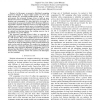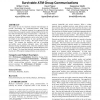194 search results - page 37 / 39 » Hypercube Network Fault Tolerance: A Probabilistic Approach |
TC
2010
13 years 6 months ago
2010
—Superpeer architectures exploit the heterogeneity of nodes in a peer-to-peer (P2P) network by assigning additional responsibilities to higher capacity nodes. In the design of a ...
LCN
2006
IEEE
14 years 1 months ago
2006
IEEE
— In this paper, we present a distributed computing framework designed to support higher quality of service and fault tolerance for processing deadline-driven tasks in a P2P envi...
EUROSYS
2008
ACM
14 years 5 months ago
2008
ACM
Programs written in type-unsafe languages such as C and C++ incur costly memory errors that result in corrupted data structures, program crashes, and incorrect results. We present...
CIKM
2007
Springer
14 years 2 months ago
2007
Springer
As a promising new technology with the unique properties like high efficiency, scalability and fault tolerance, Peer-toPeer (P2P) technology is used as the underlying network to b...
NGC
2000
Springer
13 years 11 months ago
2000
Springer
We examine the use of a hop-limit constraint with techniques to provide survivability for connection-oriented ATM group communications. A hop-limit constraint is an approach that ...


